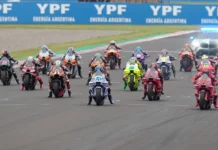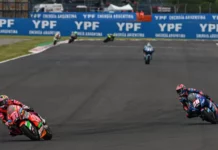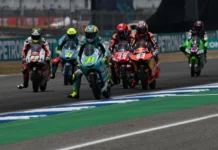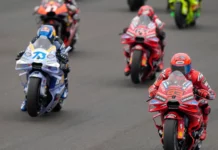THE SACHSENRING: SLOW DOESN’T MEAN EASY Michelin goes to the slow-speed but technically challenging Sachsenring aiming to build on a successful Dutch TT, where Valentino Rossi (Fiat Yamaha Team YZR-M1-Michelin) scored his third victory of the season and where three of the first four finishers were Michelin men, Nicky Hayden (Repsol Honda Team RC212V-Michelin) and Dani Pedrosa (Repsol Honda Team RC212V-Michelin) following Rossi home in third and fourth. The Assen result highlighted the progress made by Michelin with its new construction rear slick, first introduced after the third round of the 2007 MotoGP World Championship. This new construction is designed to give riders more cornering stability, edge grip and acceleration traction, as required by the new breed of 800cc MotoGP machines. Michelin has an excellent record at the German GP, having won the last 15 premier-class GPs in the country, at Hockenheim, the Nurburgring and the Sachsenring. MICHELIN AND THE TECHNICAL CHALLENGE OF THE SACHSENRING The Sachsenring is one of the slower circuits on the MotoGP calendar. The German MotoGP venue’s lap record stands at 158.546km/h, only marginally faster than the championship’s five slowest circuits: Le Mans (158.255km/h), Jerez (157.265 km/h), Laguna Seca (155.953km/h), Valencia (155.159km/h and Estoril 153.759km/h. But just because the Sachsenring is slow doesn’t mean that it’s an easy venue for tire designers. The anti-clockwise track is all corners, with barely a straight worthy of the name, thus edge grip is a vital factor of performance, simply because bikes spend so much time leaned over. The Sachsenring’s defining feature is the long succession of left-hand-handers, from turn seven to turn 11, which has bikes leaning left for around 30 seconds, building serious heat into the left side of the tires. “It is an interesting track, quite different from the others,” says Jean-Philippe Weber, Michelin’s director of motorcycle racing. “We have to use quite different products for this race, so it’s interesting for us. The Sachsenring is a challenging track because it’s rather aggressive on tires, with a lot of long corners and invariably quite hot conditions in July. The layout is very asymmetric [ten left-handers against four rights], so there is a big difference between the compounds used on the left and right sides of the rear tires, though not quite as different as at some other places we go to. “Riders need a very stable front tire at this track because there’s a lot of braking, like at the crucial penultimate corner, plus a lot of fast corner entries, for which riders need real confidence. Our 16-inch front now works well everywhere and we think it should be good at the Sachsenring, especially since riders also need light handling for the slow corners. From the rear tire, riders need excellent edge grip, stability and traction for all the long corners, which should be good for our new construction.” DEVELOPMENT OF MICHELIN’S NEW CONSTRUCTION REAR SLICK Michelin’s new construction rear slick has so far been improved in three main steps ? the first tires were tested at Istanbul, following April’s Turkish GP, the second development at Le Mans, following May’s French GP, and the third at Catalunya, following June’s Catalan GP. “The new construction we’ve been working on since April has given us some good results, especially since our last MotoGP test session after the Catalan GP,” explains Weber. “We had very good results with the latest tires during those tests, during dry practice at Donington and during the race at Assen. “We have taken the main steps with this tire, now we are optimizing the product, based on ongoing feedback from our riders. We are still pushing very hard, our development teams and the people working in R&D are working very aggressively, making various detail improvements.” SACHSENRING DATA Lap record: Dani Pedrosa (Repsol Honda RC211V-Michelin), 1:23.355, 158.546km/h-98.516mph Pole position 2006: Dani Pedrosa (Repsol Honda RC211V-Michelin), 1:21.815 Recent winners of the German GP 2006 Valentino Rossi (Camel Yamaha Team YZR-M1-Michelin), 41:59.248 2005 Valentino Rossi (Gauloises Yamaha Team YZR-M1-Michelin), 35:04.434 (shortened restarted race) 2004 Max Biaggi (Camel Honda Team-Michelin), 42:23.287 2003 Sete Gibernau (Telefonica Movistar Honda RC211V-Michelin), 42:41.180 2002 Valentino Rossi (Repsol Honda Team RC211V-Michelin), 43:32.783 2001 Max Biaggi (Marlboro Yamaha Team-Michelin), 43:36.983 2000 Alex Barros (Emerson Honda Pons-Michelin), 43:54.632 1999 Kenny Roberts (Telefonica Movistar Suzuki-Michelin), 45:59.732 1998 Mick Doohan (Repsol Honda-Michelin), 46:00.876 1997 Mick Doohan (Repsol Honda-Michelin), Nurburgring 1996 Luca Cadalora (Kanemoto Honda-Michelin), Nurburgring Michelin’s 2007 MotoGP riders Carlos Checa (Honda LCR RC212V-Michelin) Colin Edwards (Fiat Yamaha Team YZR-M1-Michelin) Nicky Hayden (Repsol Honda Team RC212V-Michelin) Shinya Nakano (Konica Minolta Honda RC212V-Michelin) Dani Pedrosa (Repsol Honda Team RC212V-Michelin) Kurtis Roberts (Team Roberts KR212V-Michelin) Valentino Rossi (Fiat Yamaha Team YZR-M1-Michelin)
Michelin Hopes To Continue Record Of Success At Sachsenring
Michelin Hopes To Continue Record Of Success At Sachsenring
© 2007, Roadracing World Publishing, Inc.






